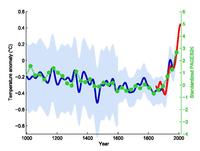
Photo from wikipedia
Abstract. Modes of climate variability strongly impact our climate and thus human society. Nevertheless, the statistical properties of these modes remain poorly known due to the short time frame of… Click to show full abstract
Abstract. Modes of climate variability strongly impact our climate and thus human society. Nevertheless, the statistical properties of these modes remain poorly known due to the short time frame of instrumental measurements. Reconstructing these modes further back in time using statistical learning methods applied to proxy records is useful for improving our understanding of their behaviour. For doing so, several statistical methods exist, among which principal component regression is one of the most widely used in paleoclimatology. Here, we provide the software ClimIndRec to the climate community; it is based on four regression methods (principal component regression, PCR; partial least squares, PLS; elastic net, Enet; random forest, RF) and cross-validation (CV) algorithms, and enables the systematic reconstruction of a given climate index. A prerequisite is that there are proxy records in the database that overlap in time with its observed variations. The relative efficiency of the methods can vary, according to the statistical properties of the mode and the proxy records used. Here, we assess the sensitivity to the reconstruction technique. ClimIndRec is modular as it allows different inputs like the proxy database or the regression method. As an example, it is here applied to the reconstruction of the North Atlantic Oscillation by using the PAGES 2k database. In order to identify the most reliable reconstruction among those given by the different methods, we use the modularity of ClimIndRec to investigate the sensitivity of the methodological setup to other properties such as the number and the nature of the proxy records used as predictors or the targeted reconstruction period. We obtain the best reconstruction of the North Atlantic Oscillation (NAO) using the random forest approach. It shows significant correlation with former reconstructions, but exhibits higher validation scores.
Journal Title: Geoscientific Model Development
Year Published: 2020
Link to full text (if available)
Share on Social Media: Sign Up to like & get
recommendations!